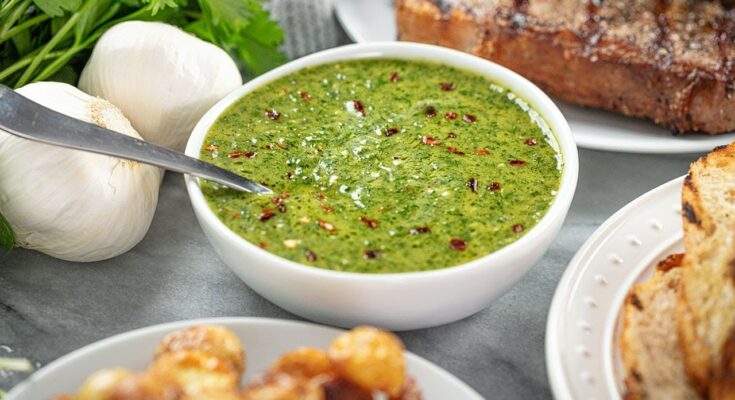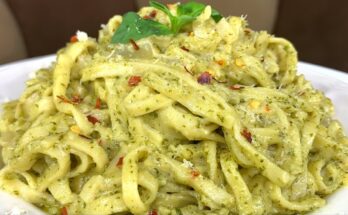Best Chimichurri Recipe: Chimichurri is that bold, zesty green sauce that instantly elevates any dish it touches. Whether drizzled over grilled steak, spooned onto roasted veggies, or swirled into a grain bowl, chimichurri packs a punch of flavor that’s hard to beat. But what exactly is this vibrant condiment, and why has it become a staple in kitchens worldwide?
Originating from Argentina and Uruguay, chimichurri is a classic herb sauce made primarily with parsley, garlic, olive oil, and vinegar. Its reputation is built on simplicity and freshness. It’s the kind of sauce that doesn’t need fancy ingredients or long cooking times—just a bit of chopping and mixing. While it traditionally accompanies grilled meats like beef and lamb, this sauce’s versatility has turned it into a global favorite.
Let’s dive deep into how to make the best chimichurri from scratch and discover why it deserves a spot in your fridge all year round.
Why Chimichurri is So Popular
So, what’s behind chimichurri’s universal appeal? The answer lies in its perfect balance of flavors. Imagine the freshness of herbs meeting the sharp tang of vinegar, rounded off with the richness of olive oil and a subtle heat from chili flakes. It’s not just a sauce—it’s an explosion of taste.
Versatility is key. Chimichurri isn’t just for steak. You can use it as a marinade, a salad dressing, or even a sandwich spread. It pairs beautifully with chicken, fish, tofu, and roasted veggies. Its adaptability makes it ideal for different diets—whether you’re a carnivore, vegetarian, or vegan, chimichurri fits right in.
Health-conscious? You’ll love it even more. Chimichurri is naturally low in carbs and sugars, making it keto and paleo-friendly. With heart-healthy fats from olive oil and the antioxidant properties of parsley and garlic, it’s a guilt-free way to add flavor to your meals.
Ingredients You’ll Need
Before we jump into the how-to, let’s talk ingredients. The charm of chimichurri lies in its simplicity, but each ingredient plays a crucial role in creating that signature zingy profile.
Here’s your shopping list:
- 1 cup fresh flat-leaf parsley (finely chopped)
- 4 garlic cloves (minced)
- 2 tablespoons fresh oregano (or 2 teaspoons dried)
- 1/2 teaspoon red pepper flakes (adjust to taste)
- 1/2 cup olive oil (extra virgin preferred)
- 2 tablespoons red wine vinegar
- Salt and black pepper to taste
Optional Add-ins for extra depth:
- A squeeze of fresh lemon juice
- 1/4 cup fresh cilantro (for a twist)
- 1 shallot or small red onion (finely minced)
Make sure your herbs are fresh, your garlic is pungent, and your oil is good quality—this sauce is raw, so every ingredient shines through. Now that we’ve got everything ready, let’s get into the magic of putting it all together.
Step-by-Step Chimichurri Recipe
Creating chimichurri is less about cooking and more about assembling. Here’s how to do it right, every single time.
Step 1: Gather Your Ingredients
Preparation is key. Wash your parsley and oregano thoroughly and pat dry. Mince your garlic and measure out your oil and vinegar. You want everything ready to go for smooth mixing.
Step 2: Finely Chop Herbs
Grab a sharp knife and finely chop the parsley and oregano. Don’t use a food processor unless you’re in a major rush—chopping by hand gives the sauce a rustic texture that’s more authentic and flavorful. Aim for a uniform chop so the herbs mix well into the sauce.
Step 3: Mix the Base
In a medium bowl, combine your chopped herbs and minced garlic. If using, add the chopped shallot or onion at this stage too. Toss in the red pepper flakes for that little kick.
Step 4: Add the Liquids
Pour in the olive oil and red wine vinegar. Stir gently to combine everything into a loose, oily mixture. This is where the magic happens—the vinegar cuts through the oil and herb base, creating that signature tang.
Step 5: Adjust to Taste
Season with salt and black pepper. Want it zestier? Add a bit more vinegar. Prefer more heat? A pinch more chili flakes. This step is all about tailoring the sauce to your preferences. Once mixed, let it sit for at least 15 minutes to allow the flavors to meld.
Now you’ve got yourself a jar of homemade chimichurri that’s bursting with flavor and ready to impress.
Tips for the Best Chimichurri Every Time
Even though chimichurri is simple to make, a few tricks can take your sauce from just okay to absolutely unforgettable. Let’s go through some tried-and-true tips to make sure your chimichurri hits the right notes every single time.
Use Fresh Ingredients
This can’t be stressed enough: chimichurri is a raw sauce, so freshness is non-negotiable. Old parsley or pre-minced garlic just won’t cut it. Always use fresh, vibrant herbs and freshly peeled garlic cloves for maximum flavor.
Let It Rest
While it might be tempting to slather your chimichurri on right away, patience pays off. Let the sauce sit for at least 30 minutes before serving. This resting time allows the ingredients to meld together beautifully, enhancing both depth and complexity.
Taste Before Serving
Everyone’s palate is different. Some prefer their chimichurri with more vinegar zing; others love a garlicky punch. Always taste your sauce and adjust seasoning before serving. Add a touch more salt, another splash of vinegar, or a drizzle of oil depending on your mood and dish pairing.
Consistency is Key
Chimichurri should be slightly chunky, not a smooth puree. You want visible bits of herbs and garlic. It’s part of the charm. Avoid over-blending, especially in a food processor, which can turn it into green mush. A coarse chop gives a rustic, traditional look and taste.
How to Store Chimichurri
Now that you’ve made this delicious sauce, what’s the best way to store it without losing that punchy flavor and freshness? Chimichurri stores well, but there are a few things to keep in mind.
Refrigeration Tips
Store your chimichurri in an airtight glass jar or container in the fridge. Because it’s made with raw garlic and herbs, you want to keep it as fresh as possible. It will last up to a week, but for best flavor, consume within 3–4 days. The oil might solidify in the fridge—don’t worry! Just let it sit at room temperature for 15–20 minutes and give it a good stir before using.
Can You Freeze Chimichurri?
Absolutely! Chimichurri freezes surprisingly well. Pour the sauce into ice cube trays, freeze, then transfer the cubes to a ziplock bag for long-term storage. This way, you can defrost just the amount you need without wasting a drop. Just note: the herbs may darken slightly in the freezer, but the flavor remains solid.
How to Use Chimichurri
Let’s talk application—chimichurri is as versatile as it is vibrant. Here are some mouthwatering ways to use it that go beyond the typical steak accompaniment.
As a Marinade
Use chimichurri as a marinade for beef, chicken, pork, or tofu. Just coat your protein in the sauce and let it sit for a few hours. The vinegar helps tenderize, while the herbs and garlic infuse deep flavor.
As a Sauce or Dip
Drizzle chimichurri over grilled veggies, spoon it over rice bowls, or serve it alongside crusty bread for dipping. It’s a great table sauce that adds a punch to almost anything.
On Different Proteins
- Steak – The classic combo. A grilled ribeye or skirt steak with chimichurri is heavenly.
- Chicken – Brush over grilled or roasted chicken thighs.
- Fish – Spoon over seared salmon or grilled white fish.
- Tofu & Tempeh – Add zest to plant-based dishes with a spoonful of chimichurri on pan-fried tofu.
Whether you’re a meat lover or a plant-based foodie, chimichurri can be your go-to green sauce for all occasions.
Common Mistakes to Avoid
Even though chimichurri is simple, a few missteps can lead to less-than-perfect results. Here are some common mistakes and how to dodge them.
Over-processing
The most common error? Using a blender or food processor and ending up with a green smoothie. Chimichurri should have texture. Use a knife and chop your herbs the old-fashioned way. It’s worth the extra few minutes.
Overpowering Flavors
Garlic is amazing—but too much raw garlic can turn your chimichurri bitter and overly sharp. Same goes for vinegar. Stick to the recommended amounts and adjust gradually. It’s easier to add than subtract.
Skipping the Rest Time
As mentioned earlier, flavors need time to blend. Rushing this process can leave you with a sauce that tastes disconnected. Give it time to rest before you dive in.
Chimichurri Variations
Once you’ve mastered the classic recipe, why not mix things up? There are a few fun variations of chimichurri that can surprise your taste buds.
Spicy Chimichurri
Love heat? Add extra red pepper flakes or throw in a chopped jalapeño or serrano chili for extra spice. A little hot sauce can also give it a nice kick.
Cilantro-based Chimichurri
Swap half of the parsley for cilantro. This gives the sauce a slightly different, more Latin-American flavor profile that works beautifully with fish tacos and grilled shrimp.
Creamy Chimichurri
Stir in a dollop of Greek yogurt or sour cream for a creamy version that works great as a dipping sauce or burger topper.
FAQs about Chimichurri Recipe
1. Can I make chimichurri in advance?
Yes! In fact, it tastes even better after a few hours in the fridge as the flavors meld together.
2. What’s the difference between chimichurri and pesto?
Chimichurri uses vinegar instead of cheese and nuts, making it lighter and more acidic. Pesto is creamier and richer.
3. Can I use dried herbs instead of fresh ones?
You can, but the flavor won’t be as vibrant. If using dried oregano, use less—dried herbs are more concentrated.
4. Is chimichurri spicy?
It has a mild kick from the red pepper flakes, but you can adjust the heat to your liking.
5. How long does homemade chimichurri last?
Up to a week in the fridge. For longer storage, freeze in ice cube trays.
Conclusion & Serving Suggestions
Chimichurri is more than just a condiment—it’s a flavor-packed experience. With its punchy garlic notes, herby freshness, and tangy vinegar bite, it can transform even the simplest of dishes. From grilled meats to roasted veggies and everything in between, chimichurri brings a bold, refreshing twist to your meals.
Pair it with:
- Grilled steak or chicken
- Roasted potatoes
- Grilled veggies like zucchini and bell peppers
- Fresh baguette or sourdough bread
- Scrambled eggs or omelets
Whether you’re whipping up a BBQ feast or just spicing up leftovers, keep a jar of chimichurri on hand—you won’t regret it.



